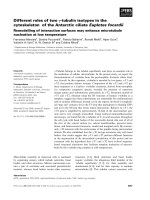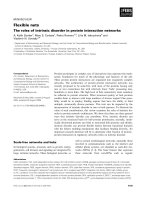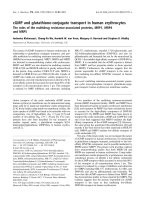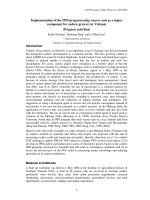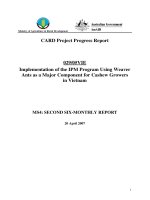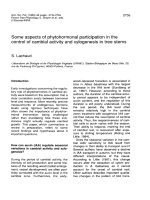The roles of some hand gestures as aspects of non verbal communication used in business setting
Bạn đang xem bản rút gọn của tài liệu. Xem và tải ngay bản đầy đủ của tài liệu tại đây (490.34 KB, 44 trang )
BỘ GIÁO DỤC VÀ ĐÀO TẠO
TRƯỜNG ĐẠI HỌC DÂN LẬP HẢI PHỊNG
--------------------------------------------------------------
ISO 9001:2015
KHĨA LUẬN TỐT NGHIỆP
NGÀNH: NGƠN NGỮ ANH
Sinh viên
Giảng viên hướng dẫn
: Bùi Trung Kiên
: Ths.Vũ Thị Thu Trang
HẢI PHÒNG – 2018
MINISTRY OF EDUCATION AND TRAINING
HAIPHONG PRIVATE UNIVERSITY
----------------------------------------------------------------------
THE ROLES OF SOME HAND GESTURES AS
ASPECTS OF NON-VERBAL COMMUNICATION
USED IN BUSINESS SETTING
GRADUATION PAPER
Student
Class
Supervisor
: Bui Trung Kien
: NA1804
: Vu Thi Thu Trang (MBA)
HAIPHONG - 2018
BỘ GIÁO DỤC VÀ ĐÀO TẠO
TRƯỜNG ĐẠI HỌC DÂN LẬP HẢI PHÒNG
----------------------------------------------------------------------------
NHIỆM VỤ ĐỀ TÀI TỐT NGHIỆP
Sinh viên: Bùi Trung Kiên
Mã SV: 1412751026
Lớp: NA1801
Ngành: Ngôn ngữ Anh
Tên đề tài: The roles of some hand gestures as aspects of non-verbal
communication used in business setting
NHIỆM VỤ ĐỀ TÀI
1. Nội dung và các yêu cầu cần giải quyết trong nhiệm vụ đề tài tốt nghiệp
(Về lý luận, thực tiễn, các số liệu cần tính tốn và các bản vẽ).
…………………………………………………………………………
…………………………………………………………………………
…………………………………………………………………………
…………………………………………………………………………
…………………………………………………………………………
…………………………………………………………………………
2. Các số liệu cần để thiết kế, tính tốn.
…………………………………………………………………………
…………………………………………………………………………
…………………………………………………………………………
…………………………………………………………………………
…………………………………………………………………………
…………………………………………………………………………
…………………………………………………………........................
3. Địa điểm thực tập tốt nghiệp.
…………………………………………………………………………
…………………………………………………………………………
…………………………………………………………………………
…………………………………………………………………………
CÁN BỘ HƯỚNG DẪN ĐỀ TÀI TỐT NGHIỆP
Người hướng dẫn thứ nhất:
Họ và tên: ……………………………………………………………..
Học hàm, học vị: ………………………………………………………
Cơ quan công tác: ……………………………………………………...
Nội dung hướng dẫn: …………………………………………………..
Người hướng dẫn thứ hai:
Họ và tên: ……………………………………………………………..
Học hàm, học vị: ………………………………………………………
Cơ quan công tác: ……………………………………………………...
Nội dung hướng dẫn: …………………………………………………..
Đề tài tốt nghiệp này được giao ngày tháng năm
Yêu cầu phải hoàn thành xong trước ngày tháng năm
Đã nhận nhiệm vụ ĐTTN
Sinh viên
Đã giao nhiệm vụ ĐTTN
Người hướng dẫn
Hải Phòng, ngày ….. tháng ….. năm 2018
Hiệu Trưởng
GS.TS.NGƯT Trần Hữu Nghị
PHẦN NHẬN XÉT CỦA CÁN BỘ HƯỚNG DẪN
1. Tinh thần thái độ của sinh viên trong quá trình làm đề tài tốt
nghiệp:
……………………………………………………………………………
……………………………………………………………………………
……………………………………………………………………………
……………………………………………………………………………
……………………………………………………………………………
……………………………………………………………………………
2. Đánh giá chất lượng của khóa luận (so với nội dung yêu cầu đã đề
ra trong nhiệm vụ Đ.T.T.N trên các mặt lý luận, thực tiễn, tính tốn
số liệu…):
……………………………………………………………………………
……………………………………………………………………………
……………………………………………………………………………
……………………………………………………………………………
……………………………………………………………………………
……………………………………………………………………………
……………………………………………………………………………
3. Cho điểm của cán bộ hướng dẫn (ghi bằng cả số và chữ):
……………………………………………………………………………
……………………………………………………………………………
Hải Phòng, ngày …… tháng ….. năm 2018
Cán bộ hướng dẫn
(Ký và ghi rõ họ tên)
NHẬN XÉT ĐÁNH GIÁ
CỦA NGƯỜI CHẤM PHẢN BIỆN ĐỀ TÀI TỐT NGHIỆP
1. Đánh giá chấ lượng đề tài tốt nghiệp về các mặt thu thập và phân
tích tài liệu, số liệu ban đầu, giá trị lý luận và thực tiễn của đề tài:
……………………………………………………………………………
……………………………………………………………………………
……………………………………………………………………………
……………………………………………………………………………
……………………………………………………………………………
……………………………………………………………………………
……………………………………………………………………………
……………………………………………………………………………
2. Cho điểm của người chấm phản biện:
……………………….................
(Điểm ghi bằng số và chữ)
Ngày ….. tháng ….. năm 2018
Người chấm phản biện
TABLE OF CONTENTS
Acknowledgement
Lists of figures, charts
PART I: INTRODUCTION
1
1. Rationale
1
2. Aims of the study
1
3. Research questions
2
4. Scope of the study
2
5. Methods of the study
2
6. Design of the study
3
PART II: DEVELOPMENT
4
Chapter I: Literature review
4
1. Non-verbal Communication
4
1.1. What is non-verbal communication?
4
1.2. Types of non-verbal communication
5
1.2.1. Body Movement (kinesic behavior)
5
1.2.1.1. What are hand gestures?
5
1.2.1.2. How to use hand gestures effectively?
6
1.2.1.3. Benefits of using hand gestures
7
1.2.2. Physical characteristics
8
1.2.3. Touching behavior
8
1.2.4. Vocal qualities (paralanguage)
9
1.2.5. Space (proximity)
9
1.2.6. Artefacts
10
1.2.7. Environment
10
1.3. The functions of non-verbal communication
10
1.4. The importance of non-verbal communication
11
2. Business setting
13
2.1. What is business setting?
13
2.2. Business communication
14
2.2.1. Definition
14
2.2.2. Types of business communication
14
2.2.2.1. Internal communication
14
2.2.2.2. External communication
14
Chapter II: Some hand gestures as aspects of non-verbal
communication used in business settings.
15
1. The roles of non-verbal communication in business settings
15
1.1. How do people communicate non-verbally?
15
1.2. How much of communication is really non-verbal?
17
1.3. The impacts of non-verbal communication
18
2. Some common hand gestures used in business settings
18
2.1. Palms together
19
2.2. Finger counting
19
2.3. Steepling
19
2.4. Open Arms – Palms Up
20
2.5. Finger and thumb Squeeze
20
2.6. Hand on Heart
20
2.7. “One more thing”
21
Chapter III: Data Analysis and comparison
21
1. Aims of the survey
21
2. Objectives of the survey
21
3. Data Analysis
21
3.1. Data collection
21
3.2. Analysis
22
3.2.1. Working environment
22
3.2.2. Meeting room
23
3.2.2.1. Activity report
23
3.2.2.2. Planning
25
3.2.2.3. Discussion
26
3.3. The roles of some hand gestures as aspects of non-verbal
communication used in business setting
27
3.4. The similarities and the differences between Vietnamese
and American in using hand gestures in business settings
27
3.4.1. The similarities
27
3.4.2. The differences
28
Part III: Conclusion
29
1. Summary
29
2. Limitations of the study
39
3. Recommendation for further study
30
References
31
ACKNOWLEDGEMENT
Sincerely, I would like to show my deep gratitude to many people for their
kindness and helpfulness to me during my preparation and completion for
the graduation paper.
Firstly, I am so grateful to Ms. Vu Thi Thu Trang (MBA), the supervisor,
who enthusiastically gave me guidance and correction for my research.
Secondly, I would like to express my sincere thanks to Ms. Tran Thi Ngoc
Lien (MA), the Dean of Foreign Language Department and all the teachers
at Haiphong Private University for the precious and useful lessons in my
study process that helped me a lot during graduation time.
Last but not least, I would like to give my heartfelt thanks to my family, my
friends who always, encourage and inspirit me to complete this graduation
paper.
Haiphong, June, 2018
Bui Trung Kien
LIST OF FIGURES, CHARTS
Figures
Figure 1: Palms together
Figure 2: Finger counting
Finger 3: Steepling
Figure 4: Open Arms – Palms Up
Figure 5: Finger and thumb Squeeze
Figure 6: Hand on Heart
Figure 7: “One more thing”
Charts
Chart 1: Frequency of using hand gestures of Vietnamese and American in
working environment.
Chart 2: Frequency of using hand gestures in report activity.
Chart 3: Frequency of using hand gestures in planning.
Chart 4: Frequency of using hand gestures in discussion.
Part I: INTRODUCTION
1. Rationale
In business settings, communication is an essential part for work; it helps
working process run smoothly without misunderstanding. Usually, besides
verbal communication which is used frequently, non-verbal communication
also plays an important role in daily interaction in business context.
Especially, hand gestures are considered as the most effective way to
communicate because of their significant conveying messages.
Hand gestures are means to assist people not only to communicate
successfully with each other but also to express our feelings. It can be said
that these hand gestures are highly important in person-to-person
communications without language in common. The meanings of hand
gestures may be understood in various ways in different cultures.
It is undeniable that newly graduates will definitely need to be prepared for
business communication skills; thus, in this graduation paper, the use of
hand gestures – an important part of non-verbal communication – will be
concentrated and analyzed, so that they could help readers understand and
improve their ability of speaking without words.
Based on the importance and requirement of non-verbal language,
especially hand gestures, some useful hand gestures in business setting will
be listed and emphasized in this graduation paper. They are able to help
young students understand and practice in future business environment.
2. Aims of the study
The study is conducted to:
Point out the similarities and the differences in using hand gestures
between two main objects: Vietnamese and American in daily work
environment and in meeting rooms.
Suggest some hand gestures which Vietnamese can practice
effectively in business settings.
1
3. Research questions
The study is conducted to answer the following questions:
- What are the roles of some hand gestures as aspects of non-verbal
communication used in business setting?
- How different are some hand gestures used by Vietnamese and American
in business settings?
4. Scope of the study
Hand gestures in business setting are a broad theme so the researcher does
not aim to cover all aspects of this non-verbal communication issue.
Therefore, in this paper, several common types of hand gestures (Palms
together, Finger counting, Steepling, Open Arms – Palms Up, Finger and
thumb Squeeze, Hand on Heart, and “One more thing”) are focused.
Benefits of using hand gestures will also be listed that can help readers
understand and apply to communicate with one another or in groups.
Furthermore, actual data from a survey will be given out to make readers
clearer about using hand gestures in a specific company and the differences
in the ways people use them.
5. Methods of the study
To researcher of this study focuses on using qualitative and quantitative
methods with regarding to the qualitative method, observation was carried
out. The conversations between Production Manager and staffs in daily
work environment and in meeting room of Production Department were
observed carefully to find out the differences of their way of using hand
gestures. Also, quantitative method is used in the form of a thorough data
analysis. This is conducted to have an insight of the collected data.
2
6. Design of the study
The study is divided into three main parts:
The first part is the introduction which combines the reasons for choosing
the topic, the aims of the study, research questions, the scope of the study
as well as the methods applied.
The second part is the development which includes three chapters:
The first chapter deals with the theoretical background to provide
readers with the knowledge of general non-verbal communication,
especially hand gestures used in business setting.
The next chapter focuses on how non-verbal communication happens
and some useful hand gestures suggested to practice in the contexts of
business.
The third part provides readers data from a survey which was conducted
to answer the research questions.
The last part is the conclusion of the study. All the information from the
previous parts of the study is summarized in this part.
3
Part II: DEVELOPMENT
Chapter I: Literature review
1. Non-verbal communication
It can be said that non-verbal communication is an outstanding aspect of
communication in daily life of human and plays a vital role in person-toperson situations.
1.1. What is non-verbal communication?
According to Knapp (1972), non-verbal communication just demonstrates
actions and expressions without using words, these meaningful things are
shown.
Therefore,
non-verbal
communication
describes
“all
communication events which transcend spoken or written words”. It cannot
be confirmed as a full definition of non-verbal communication. Thus, there
are many authors who have different opinions about this type of
communication.
According to Levine and Adelman (1993): “Non-verbal communication is
the “silent” language, including the use of gestures, facial expressions, eye
contact, and conversational distance”. Body language and a minor part of
environment language are emphasized but it is still not enough to show us a
clear view about non-verbal communication.
One more general view by Dwyer (2000), non-verbal communication
covers all parts of a message that are not encoded by words; for example:
voice, presence or gesture and motion.
In summary, behavior and elements of speech aside from the words
themselves that transmit meaning. Non-verbal communication includes
pitch, speed, tone and volume of voice, gestures and facial expressions,
body posture, stance, and proximity to the listener, eye movements and
contact, and dress and appearance.
4
1.2. Types of non-verbal communication
There are many classifications of non-verbal communication. Dwyer
presents classification by area: body movement (kinesic behavior), physical
characteristics, touching behavior, vocal qualities (paralanguage), space
(proximity), artefacts, and environment.
1.2.1. Body movement (kinesic behavior)
Description: Body posture (the way a person stands, leans forward or back
and moves the head), body movements (eye, head, hand, feet and leg
movements) and facial expressions all affect the message.
Example: A person leaning forward, pointing and shaking a finger at
someone is seen as trying to dominate the other person. Fiddling with
jewelry or pens may convey nervousness and insecurity.
1.2.1.1. What are hand gestures?
Gestures are a form of non-verbal communication in which visible bodily
actions are used to communicate important messages, either in place of
speech or together and in parallel with spoken words. Gestures include
movement of the hands, face, or other parts of the body. Physical nonverbal communication such as purely expressive displays, polemics or
displays of attention differ from gestures, which communicate specific
messages. Gestures are culture-specific and can convey very different
meanings in different social or cultural settings.
Gesture is distinct from sign language. Although some gestures, such as the
ubiquitous act of pointing, differ little from one place to another, most
gestures do not have invariable or universal meanings but connote specific
meanings in particular cultures. A single emblematic gesture can have very
different significance in different cultural contexts, ranging from
complimentary to highly offensive.
5
1.2.1.2. How to use hand gestures effectively?
Whether we realize it or not, hand gestures are a constant part of our
communication. Hand gestures can act as a second language of sorts; make
people listen to you more intently, feel more comfortable around you, or
even add an air of authority to your words. Since it's such a common mode
of communication, using hand gestures effectively is important. Whether
it's helping more clearly convey a point, creating a more comforting
persona to those around you, or simply looking more confident, knowing
how to use hand gestures effectively can go a long way to making you a
better communicator.
Mastering effective hand gestures
Use hand gestures to add emphasis to speech. Hand gestures can be
a way to add more force to what you're saying. These are often
known as "illustrative gestures”.
Use open hands and palms up for a positive effect. Whether you're
speaking in front of a large group of people or one individual, hands
facing up usually invite positive responses from people.
Keep hands behind your back to show confidence. Much like hands
up front can show defensiveness, hands behind the back with an
exposed torso shows confidence.
Finding uses for hand gestures
Use persuasive hand gestures. You can give off an air of authority
and be more convincing by using hand gestures to seem persuasive.
Use hand gestures to aid in memorization. Just as talking about
what you learn helps encode memories more effectively, hand
gestures have a similar affect.
Use hand gestures to recall information. When you are having
trouble remembering information, gesturing with your hands can
help you bring the words to mind.
6
Avoiding ineffective hand gestures
Avoid
using
hand
gestures
that
convey
nervousness
or
diffidence. Even if you think you are comfortable talking to someone,
a number of ways you move your body can betray this.
Do not cause a distraction with your hands. While hands can
certainly make you a more effective communicator, and even cause
people to be more comfortable around, they can also detract from
your ability to communicate effectively.
Do
not
use
hand
gestures
to
compensate
for
verbal
sputtering. Sometimes people who have trouble finding words use
hand gestures as a sign of nervousness or distraction.
1.2.1.3. Benefits of using hand gestures
Hand gestures often help emphasize certain points of speeches and
strengthen the speaker’s message. Research shows that stronger speakers
use hand gestures, and here are some common motions people use while
speaking. People pay attention to the motions being taken during speeches.
If you purposely use your body to stress a certain idea, the audience is
much more likely to remember what you said. The movement draws
attention to what you are saying at that moment and draws attention to the
important parts of the speech. A lively speaker leaves a larger impression
on listeners than an immobile individual.
When you are sitting listening to a lecture, it can get really tempting to just
close your eyes and drift off, especially if the person giving the speech is
not doing a great job in trying to engage the audience. No one likes to sit
through hours and hours of a flavorless lecture, no matter how interesting
the topic may be. Using hand gestures can make the speaker more
animated, and it is much more pleasing to the eye to have a moving
lecturer as opposed to a stationary speaker the entire time. It is not that the
lecturer is boring per say, but more that using motions would prompt more
7
people to stay alert during the presentation. However, hand gestures may
not be the way to go for everyone. Do not randomly insert them into
speeches if you do not feel comfortable doing so because it will only come
off as unnatural and awkwardly placed.
Not only does being a strong speaker help you in school/work but can
come in use during daily conversations. You practice how you play - these
habits carry over into our daily lives, and we find ourselves gesticulating
wildly in the middle of a conversation with a friend. Doing so is not wrong,
but excessive hand motions can seem awkward in a normal conversation
(especially if you knock something over).
1.2.2. Physical characteristics
Description: Physical characteristics, first impressions and images of
others can be associated unconsciously with past experiences of people
with similar characteristics. They are important parts of non-verbal
communication.
Example: people react to factors such as body shape, general attractiveness,
body and breath odors, weight, hair and skin color. These factors often
determine our responses in interpersonal encounters.
1.2.3. Touching behavior
Description: Touching can console or support the other person and show
feelings such as affection, sexual interest or dominance. Hand gestures
demonstrate feelings and convey thoughts and words through movement. A
handshake, for example, can express either dominance or equality.
Example: Stroking, hitting, holding or guiding the movements and another
person are touching behaviors that communicate non-verbally. Each adds a
different meaning to a message – a part on the arm can convey intimacy or
control. Some touching is ritualistic, such as a handshake as a greeting.
8
1.2.4. Vocal qualities (paralanguage)
Description: Paralanguage is that part of language associated with, but not
involving, the word system. It consists of the voice qualities and
vocalizations that affect how something is said rather than what is said.
Vocalizations, the tone of voice, rate of speaking and voice inflection are
an important part of the total message.
Example: Voice qualities include pitch range, pitch control, rhythm control,
tempo, articulation control and resonance. Vocalizations (such as signing,
groaning, volume, “um” and “ah”) also give clues to the total message. A
tired person will speak more slowly than usual; a disappointed person may
speak with a flat tone.
1.2.5. Space (proximity)
Description: Proximity means nearness, in term of physical space. Hall
(1969) identified four distances that people maintain between themselves
and others:
1. Intimate space is 0 – 45 cm.
2. Personal distance is 45 – 120 cm.
3. Social distance is 1.2 - 3.6 m.
4. Public distance is 3.6 m to out of sight.
Example: Personal space varies according to gender, status, roles and
culture. People can use their height and weight to convey a message; for
example, towering over another in their personal space may cause
discomfort and withdrawal. When speaking to acquaintances or work
colleagues about an arm’s length of space is usual, to friend and family
about half an arm’s length is fine, and intimate relationships contact is
direct and close.
9
1.2.6. Artefacts
Description: Artefacts are objects used to convey non-verbal messages
about self-concept, image, mood, feelings or style. Mary artefacts are
common to the group. Others (particularly clothing) are an individual,
highly visible part can create a positive or negative first impression.
Example: Perfume, clothes, glasses and hairpieces project the style of
mood of the wearer. A police badge, a nurse’s uniform and an Italian suit
can signal power of lack of power in a situation. If a plain-clothes police
officer show the police badge at an accident, others immediately perceive
the person’s authority.
1.2.7. Environment
Description: Office space, factory layout, the sales area and conference
venues have an impact on perceptions, morale and productivity. The
environment should match expectation: an unsuitable environment can
produce “noise” that causes communication barriers.
Example: Natural and artificial light, color, temperature, tables, chairs,
desks, lounges, plants, sound, artwork, magazines, and floor and wall
coverings all have an impact. The environment should satisfy instincts,
such as the need for privacy, familiarity and security.
1.3. The functions of non-verbal communication
Usually verbal and non-verbal communication operate together, however
the meaning of the spoken word may differ from the message transported
by body language. According to Wertheim, non-verbal cues can play the
following roles in combination with speech:
Repetition: Pointing the way to somebody who has asked for
the direction to the next grocery store is repeating a verbal
message by sign; also: e.g. putting the hand to the ear when
saying “I can’t hear you”.
10
Contradiction: Non-verbal cues can even be the opposite of
what somebody is saying. If someone with a red face and
bulging veins cries: “Angry? I’m not angry!” This behavior is
also shown when somebody wants to be ironical or cynical.
Substitution: A non-verbal cue can replace spoken words. A
common example is shrugging the shoulders instead of giving
a verbal answer.
Complementing:
Complementing
behavior supports the
spoken word. If a boss pats a person on the back while giving
praise, this increases the impact of the message.
Accenting: Gestures may emphasize a verbal message, for
instance stressing the statement: “It was your idea!” with
pointing an accusing finger.
Adler and Rodman add a sixth function of non-verbal communication to
the Wertheim list:
Regulating: If a speaker comes to the end of his oration, the
unstated rule is: Create a rising vocal intonation pattern, then
use falling intonation, or draw out the final syllable of the
clause. If the speaker wants to continue when another speaker
seems to be ready to cut off, he can suppress the attempt by
taking an audible breath, using a sustained intonation pattern
and avoiding any pauses.
Functions of non-verbal communication are universal, no matter which
country or context.
1.4. The importance of non-verbal communication
The importance of non-verbal communication cannot be overlooked. In
fact, people just begin to pay attention to it since publication of Julius
Fast’s book telling about body language in 1970s. Up to now, there are
11
many research works which are implemented in order to make statements
about the importance and independence of this type of communication.
According to Pease (1984): “The fascinating thing is that the human animal
is rarely aware of his postures, movements and gestures that can tell one
story while his voice may be telling another”.
Mehrabian (1972) also gave specific numbers: in the overall effect of a
message, the verbal elements (words) make up 7% only; meanwhile, vocal
factors (including voice, fluctuations and other sounds) account for 38%
and non-verbal factors account for 55%.
In casual communication, according to Levine and Adelman, 93% of the
message is conveyed by tone and facial expression; only 7% of the
message is transmitted in words.
Some authors point out three reasons for the importance of nonverbal
communication:
- Firstly, it is easier to remember what people see than what they
hear.
- Secondly, non-verbal communication occurs more than verbal
communication.
- Thirdly, people can easily be deceived by verbal communication,
but it is much more difficult with non-verbal communication.
In conclusion, communication is an important aspect in human life. It
is the way one expresses ones knowledge, emotions and skills. Non verbal communication plays an important role in the communication
process; it determines how one interprets the informat ion and actions
of others. Non-verbal messages can be conveyed through eye contact,
gestures, body language, touch and facial expressions. One needs to be
skilled in non-verbal communication and he should also be able to
interpret it for smooth flow of communication in any relationship.
When the non-verbal signals do not match the words or action of the
12
speaker, it leads to misunderstanding, confusion and mistrust among
the audience.
Non-verbal communication plays a vital role in the work place, as co workers interact in different ways, while working in a team, meetings,
subordinate and high authority communication and so on. Therefore,
the way in which things are expressed and conveyed is very important
for the management and overall progress of the organization. Thus,
one constantly needs to develop and improve one’s non -verbal
communication. One should be able to understand the nonverbal
communication of the co-workers; When making non-verbal signal
one should make sure that they are not confusing, and the audience is
able to understand what he is trying to say; ones non -verbal signals
should be in line with the situation and context; The tone should
match the words; one should speak with appropriate eye contact and
so on.
One needs to be careful while using non-verbal communication, as
different communities and cultures interpret these non -verbal signals
in different ways; therefore, one should use them with caution and
with the full knowledge about them, they should ensure that by doing
so they are not hurting the sentiments of a community or a person. The
understanding of non-verbal communication signals comes from
constant observation, analysis, experience and regular prac tice over
time.
2. Business setting
2.1. What is business setting?
Business setting, in other words, can be called business environment. The
combination of internal and external factors that influence a company's
operating situation. The business environment can include factors such as:
clients and suppliers; its competition and owners; improvements in
13


